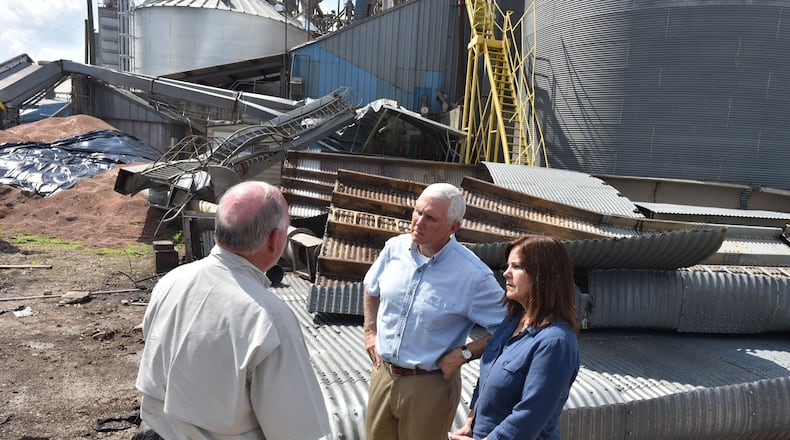Last month, dozens of farmers and local bankers gathered in the South Georgia town of Doerun, a farming community still aching from the damage wrought by Hurricane Michael, to celebrate Congress' passage of a long-awaited disaster relief bill and learn about what's next. What they heard from state officials was a broad outline that help was on the way – but few specifics.
“We’ve got a lot of details to work out, but we believe we have a plan that will work,” state Agriculture Commissioner Gary Black said. “We’re ready to go.”
When President Donald Trump put his signature on the $19.1 billion relief package on June 6, he freed up federal dollars for Georgians still struggling to recover from Michael and other natural disasters from the past 18 months. But it will likely take weeks or months — and potentially the better part of a year — for money to filter down to the state.
That's because the funding must first pass through dozens of individual federal agencies, which are currently interpreting Congress' guidance to determine who is eligible to receive the emergency funding.
The Atlanta Journal-Constitution contacted nearly two-dozen federal and state agencies, congressional offices and trade groups that will have a hand in parceling out the money and making sure it ends up in the right places.
None could pinpoint how much money will ultimately go to Georgia or when it’ll arrive, but the expectation is that the aid will be focused on the 108 counties that were declared disaster zones under the Category 5 Michael, which battered the southern portion of the state on Oct. 10.
Pots of funding
Each agency implementing the new law will set its own terms for where its money will go. Some could release their money quickly, especially if they have time-tested aid programs already in place. Others could take months as they assess unmet needs and design new relief programs with the blessing of the White House budget office.
The bureaucratic morass could mean that some locals see Michael’s one-year anniversary pass before they receive a substantial amount of recovery funding.
In some cases, Georgia agencies are already working with their federal counterparts to pinpoint the areas of greatest need. Many are waiting for guidance from the feds so they can draw up proposals that must ultimately be approved by their D.C. counterparts.
Georgia will likely be eligible to receive money from several different federal programs.
It could claim a slice of the $1.6 billion the U.S. Department of Transportation recently received to reimburse state and local governments that repaired federal roads following storms.
Depending on the way the programs are designed, local governments could apply for economic development grants from the Commerce Department and money from the Environmental Protection Agency to build more resilient wastewater treatment systems.
A major source of recovery funding is expected to come from the Department of Housing and Urban Development, which uses block grants to rebuild damaged housing and businesses that weren’t covered by private insurance, the Federal Emergency Management Agency and Small Business Administration-backed loans.
HUD recently awarded the state nearly $35 million in block grants to handle infrastructure damage from Hurricane Michael. More is expected to head toward southwest Georgia after HUD finalizes its plan for divvying up an additional $2.5 billion in community development money from the disaster relief bill. However, that process is generally slow-moving as the department pulls in data about what's already been covered by other funding sources.
Once the guidelines are set, the state will submit its plan for using the money that must ultimately be approved by the feds.
Tommy Lowmon from the Georgia Department of Community Affairs said the agency’s first priority will be to fulfill unmet housing needs, and HUD typically requires the lion’s share of block grants to be spent in low-income areas.
Farm aid
The largest pool of federal funding that will trickle down to the state is expected to come from the U.S. Department of Agriculture.
The need is substantial. The state’s agriculture sector suffered more than $2.5 billion in damage from Hurricane Michael, according to an estimate from the University of Georgia.
The federal government won’t come close to filling the gap — the USDA was given about $3 billion to account for crop and livestock losses from multiple major natural disasters that hit across the nation between 2017 and 2019 — but the money could help soften at least some of the blow for local farmers still struggling to recover from Michael.
U.S. Agriculture Secretary Sonny Perdue, who once represented portions of the affected area in the Georgia Senate, has yet to release details of how he will distribute the money. But the department is expected to divide it between state block grants and more conventional payments to farmers who lost crops based on where they live and how much they lost.
State officials, including Gov. Brian Kemp and members of the congressional delegation, have been pushing for block grants, which they think will be a more flexible way to quickly deliver the money, especially to pecan and timber farmers who experienced generational damage from Michael.
Bill Northey, the USDA undersecretary for farm production and conservation, said in an interview that the department is currently gathering information from state and federal agencies, agriculture associations, universities and other groups to assess “each of these losses and trying to figure out the best approach” to delivering aid money.
After that, the department will draft aid guidelines, get them approved by the White House budget office and develop software for eligible farmers to apply for the aid, a process Northey acknowledged could take “certainly many weeks.”
“It does take a little bit of time to put each of those pieces together, but our desire is to get it out as quick as we can while having it as solid as we can,” he said. “Hopefully we’ll be of support to folks trying get through this.”
Black, the state agriculture commissioner, recently convened two stakeholder groups to develop recommendations for the department. One item on their wish list, Georgia Department of Agriculture spokeswoman Julie McPeake said, is to use federal block grants to match the $75 million in low-interest loans the Legislature approved after Michael. Proponents think the loans could be of particular help for pecan and timber farmers.
There is some fear that the money may be too late for some Georgia farmers.
Many were forced to make irreversible financial decisions during the planting season in early spring. Some flirted with bankruptcy filings or mortgaged off pieces of land to secure independent financing, while others delayed or skipped planting altogether.
Still, many of the farmers who attended the Doerun event indicated the cash infusion would be helpful to the region.
“We won’t have it long,” Dick Minor, an Americus vegetable and fruit farmer, said of the money. “It goes into our accounts, and it will be farmed out to banks, landlords, seed sales, tractors — it will spur the rural economy.”
About the Author
Keep Reading
The Latest
Featured



